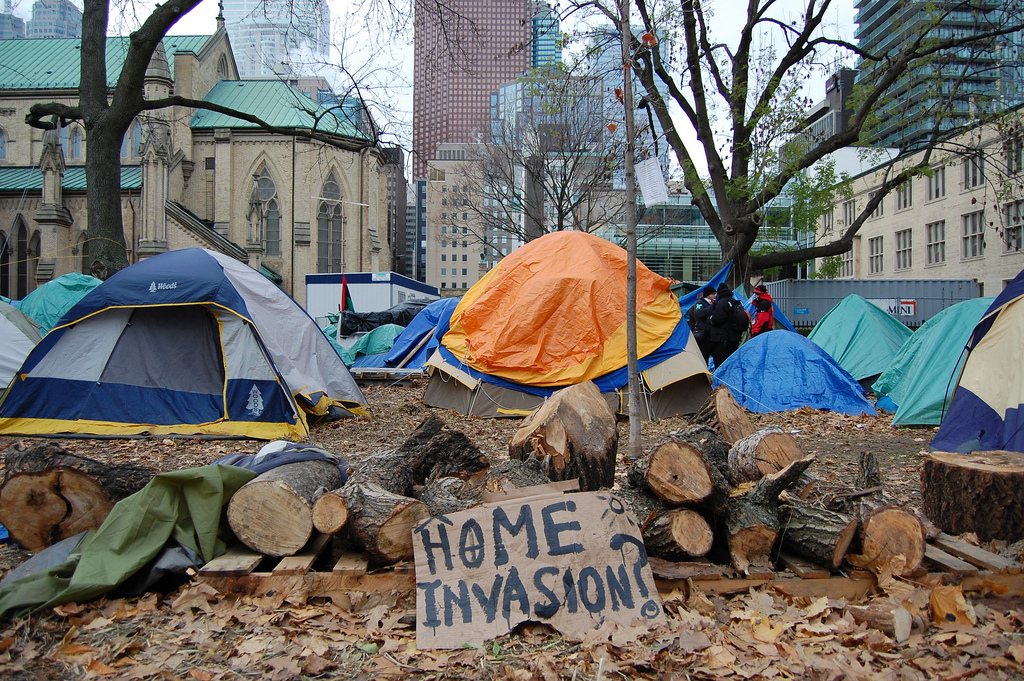Well, it’s fall in Toronto and that can mean only one thing.
OK, it can mean a lot of things actually but since 2011, a small group of the 99 per cent can remember unzipping their tents in the chilly dew-filled mornings unsure of how many days they had left sleeping in those tents — and how to stave off their eventual eviction.
I’m of course talking about Occupy, that phenomenon that taught the general public about concepts like “the 99%” — even though they actually demographically comprised it but didn’t yet know it. And maybe wouldn’t ever know it.
But hey, what is a little cognitive dissonance from people when you are trying to talk to them about revolution?
Back then, there were those who were sure that Occupy would unite the 99% of us — while the rest of us kinda just went along for the ride. They gave up their lives — not literally like the Arab Spring but their comforts — to try and nurture that tiny-big dream of winning hearts and minds and warm food at St. James Park.
And in the early days, people really believed that the Occupy movement was exactly what the world needed — when seen in the context of the Arab Spring and now Black Lives Matter — because it reunited us with the concept of occupation-as-protest tactic.
While other communities already understood the concept of occupation-as-protest tactic — Wounded Knee or Alcatraz as an example, it was still pretty new to some people. These were pretty much the same kids who were too young to participate in the epic, 2001 FTAA demonstrations in Quebec City, and had cut their teeth on the G20 demonstrations.
And we saw those people stumble and learn as they moved through the first afternoon to the first night which led to days which led to weeks.
I’m sure that Toronto was not unique in its share of people who gave up their romantic partners, their jobs and their apartments to commit to Occupy wholly.
While the crippling uncertainty of being homeless was not new to the residents of St. James Park before Occupy Toronto came to town, it eventually (hopefully) dawned on at least half of the 99 per cent who participated in Occupy that our presence and eventual eviction from the park actually ended up displacing those people who had called the park home before Occupy showed up.
One of the most maddening parts about Occupy for me was the amazing counter-protest (and cheering on of our eventual eviction) not set up by the people who had lived in that park before we pushed them out, but by the cheering local dog owners and dog walkers of the area who seemed incensed at the inconvenience of finding another location where their dogs could poop.
In Toronto, Occupy lasted for 40 days and nights, as the weather turned from slightly cold to a real health hazard that organizers were not prepared for — having to consider how to winterize the camp. In this serious dilemma, it became clear that while part of the 99 per cent who stayed on at the camp were prepared for the long haul even throughout winter, more and more people began showing up at the General Assemblys concerned that we were just not ready for the coming winter.
I remember being one of the first people to express concern for the people that the camp was not going to survive the winter. For example, if everyone slept alone in their own tents they would not be able to generate enough body heat to stay alive throughout the night. Other issues raised were the concern for individuals who were not in the best of health and/or who suffered from alcoholism which thins the blood and makes it easier to stay warm.
Another issue was fire. And for right now, I’m not speaking about the Sacred Fire but people trying to stay warm by lighting from twenty to thirty tea light candles to keep warm only for their bedding or the tent themselves to catch on fire. That was not the only case of a structure catching fire.
I was away from the camp that day as I had to keep an MRI appointment at the hospital only to get a call from a Toronto Star reporter telling me about a fire. At that time, the size was unknown and it seemed like a nightmare realized. It turned out that the fire was minor, but it did focus people’s attention on the health and safety of the camp.
Over the next few days until October 15, I’ll be reflecting on different aspects of the 40 days and 40 nights of Occupy and the planning — at least in Toronto — for a five-year anniversary, including the history of the movement.
It’s a fascinating story that is more about the people who made up Occupy, and the audacity of Occupy’s existence and definition of the 99 per cent, than about the eviction notice.
The next post will look into the nuts and bolts of how Occupy came to be.
Like this article? rabble is reader-supported journalism. Chip in to keep stories like these coming.
Image: Phil Drinkwater



